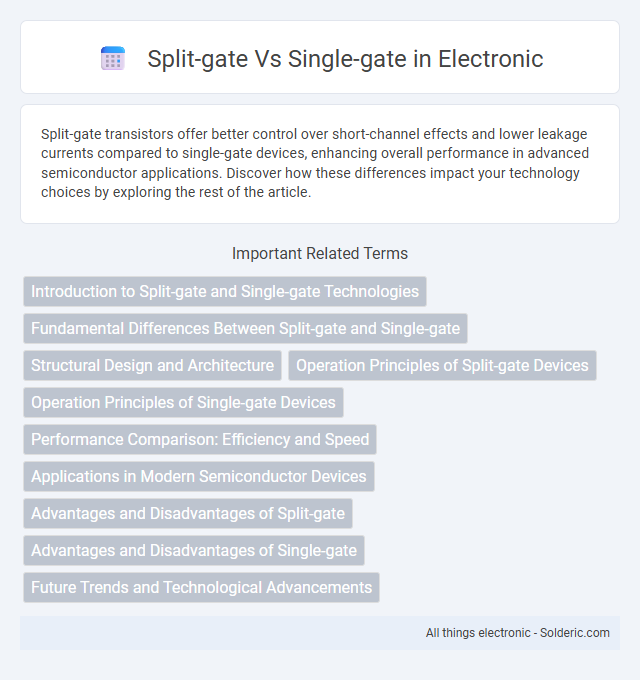Split-gate transistors offer better control over short-channel effects and lower leakage currents compared to single-gate devices, enhancing overall performance in advanced semiconductor applications. Discover how these differences impact your technology choices by exploring the rest of the article.
Comparison Table
| Feature | Split-Gate | Single-Gate |
|---|---|---|
| Gate Structure | Two separate gates controlling the channel | One continuous gate controlling the channel |
| Control | Better electrostatic control; reduced short-channel effects | Standard electrostatic control; more short-channel effects |
| Leakage Current | Lower leakage due to improved gate control | Higher leakage current under scaling |
| Fabrication Complexity | More complex due to multiple gates | Simpler fabrication process |
| Performance | Higher performance at nanoscale, better scalability | Performance limited by short-channel effects |
| Applications | Advanced CMOS, low-power devices | Conventional MOSFETs, general-purpose circuits |
Introduction to Split-gate and Single-gate Technologies
Split-gate and single-gate technologies represent key transistor architectures in modern semiconductor devices, with single-gate transistors featuring a single control gate to modulate the channel, while split-gate transistors incorporate multiple gates to independently control different regions of the channel. Split-gate designs enhance device performance by reducing short-channel effects and improving threshold voltage control, making them suitable for advanced memory and logic applications. Understanding these differences helps you select the optimal transistor structure for improved power efficiency and device scaling in integrated circuits.
Fundamental Differences Between Split-gate and Single-gate
Split-gate transistors feature two independently controlled gates that enable enhanced control of the channel, reducing short-channel effects and improving device scalability compared to single-gate transistors, which utilize a single gate electrode. The fundamental difference lies in the split-gate structure's ability to modulate the channel potential more precisely, resulting in better electrostatic control and lower leakage currents. Your choice between split-gate and single-gate designs impacts power efficiency, switching speed, and overall transistor performance in advanced semiconductor applications.
Structural Design and Architecture
Split-gate transistors feature two independently controlled gates separated by a dielectric, enabling enhanced control over channel conduction and reduced short-channel effects compared to single-gate transistors. The single-gate architecture employs a single gate electrode directly controlling the channel, offering simpler fabrication but limited electrostatic control, especially in nanoscale devices. Split-gate design improves device scalability and leakage current suppression by better managing the electric field distribution across the channel.
Operation Principles of Split-gate Devices
Split-gate devices operate by using two gates: one controls the electron flow in the channel, while the other modulates the potential barrier, enabling precise control over current and charge confinement. This configuration allows for enhanced electrostatic control, reducing short-channel effects compared to single-gate devices, which rely on a single gate to modulate the channel conductivity. Understanding the operation principles of split-gate devices allows you to leverage their advantages in applications requiring improved switching characteristics and scalability.
Operation Principles of Single-gate Devices
Single-gate devices operate by controlling the charge flow through a single gate electrode that modulates the conductivity of the semiconductor channel beneath it. This structure relies on the electrostatic influence of the gate voltage to create a conductive path for carriers between the source and drain terminals. The single-gate mechanism is straightforward, enabling efficient switching and amplification but may face challenges like short-channel effects in advanced scaling.
Performance Comparison: Efficiency and Speed
Split-gate transistors offer enhanced performance over single-gate devices by reducing short-channel effects and improving electrostatic control, leading to higher efficiency and switching speed. The dual-gate structure in split-gate transistors provides better channel modulation, resulting in faster response times and lower power consumption compared to single-gate counterparts. Your choice between these architectures impacts overall device speed and energy efficiency, with split-gate designs typically delivering superior performance in high-speed applications.
Applications in Modern Semiconductor Devices
Split-gate transistors provide enhanced control over the channel region, making them ideal for non-volatile memory applications like flash storage and advanced logic circuits. Single-gate devices dominate in general-purpose microprocessors and digital integrated circuits due to simpler fabrication and effective switching performance. Your choice depends on device requirements; split-gate structures excel in precision and reliability, while single-gate transistors offer efficient power consumption and scalability.
Advantages and Disadvantages of Split-gate
Split-gate transistors offer improved control over charge injection and leakage currents compared to single-gate devices, enhancing memory performance and reducing power consumption in flash memory applications. However, split-gate structures are more complex to manufacture, leading to higher fabrication costs and potential yield issues. Single-gate transistors feature simpler design and lower production expenses but often suffer from increased leakage and less precise control over channel behavior.
Advantages and Disadvantages of Single-gate
Single-gate transistors offer simpler device architecture and ease of fabrication, making them cost-effective and widely used in conventional CMOS technology. Their disadvantages include limited control over short-channel effects and higher leakage currents compared to split-gate designs, which can reduce device performance and power efficiency. Your choice depends on balancing manufacturing complexity with the required electrical characteristics for the intended application.
Future Trends and Technological Advancements
Split-gate transistors are gaining traction in memory technologies like NAND flash for enhanced scalability and reduced interference, promising longer device lifespan and higher density compared to single-gate designs. Future trends emphasize integrating AI-driven design optimization and advanced materials such as 2D semiconductors to further boost performance and efficiency in split-gate devices. Understanding these technological advancements can help future-proof your engineering projects by leveraging the superior control and reliability offered by split-gate architectures.
Split-gate vs Single-gate Infographic

 solderic.com
solderic.com